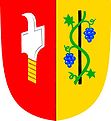Vlčnov
| Vlčnov | ||||
|---|---|---|---|---|
|
||||
| Basic data | ||||
| State : |
|
|||
| Region : | Zlínský kraj | |||
| District : | Uherské Hradiště | |||
| Area : | 2130 ha | |||
| Geographic location : | 49 ° 0 ' N , 17 ° 35' E | |||
| Height: | 226 m nm | |||
| Residents : | 3,012 (Jan 1, 2019) | |||
| Postal code : | 687 61 | |||
| License plate : | Z | |||
| traffic | ||||
| Street: | Hluk - Uherský Brod | |||
| structure | ||||
| Status: | local community | |||
| Districts: | 1 | |||
| administration | ||||
| Mayor : | Jan Pijáček (as of 2010) | |||
| Address: | Vlčnov 124 68761 Vlčnov |
|||
| Municipality number: | 592820 | |||
| Website : | www.vlcnov.cz | |||
Vlčnov (German Wiltschnau , older Hauerschilt ) is a municipality in the Okres Uherské Hradiště in the Czech Republic. It is located twelve kilometers southeast of Uherské Hradiště and belongs to the Zlínský kraj region .
history
Vlčnov was first mentioned in a document in 1264. However, archaeological excavations indicate that the area was already inhabited before. Since the 13th century the place was owned by the lords of Riesenburg , who built a fortress here. Later Vlčnov was a margrave fief of the Jobst of Moravia . After the Hussite Wars , Burian von Vlčnov acquired further lands and in 1449 the Světlov Castle , which became his family seat next to Vlčnov. This family used the predicate "von Vlčnov" until the middle of the 16th century.
In 1506 Vlčnov acquired Johann von Kunowitz . Since then, the history of the village has been closely linked to that of Uherský Brod , which was the seat of the Kunowitz family. Vlčnov also became a simple municipality among them without any special privileges.
Like other municipalities in Moravian Slovakia , Vlčnov was originally a purely agricultural village, in which every building and every yard with the associated land was an independent agricultural unit. One of the duties of the Vlčnov subordinates to the authorities was to give in kind on the day of St. George and St. Wenceslas.
In the 16th and 17th centuries, the vineyards were expanded. The greatest boom occurred in the middle of the 17th century when the total area of the cultivated and overgrown vineyards was 95 hectares. In place of the overgrown vineyards, on the Mäuseberg ( Myší hora ), a wildlife park was created that covered the hill. Here let Wenzel Robert von Kaunitz 1903-1905 the castle Pepčín build; In 1981 it was demolished. A school was built in the community in 1861, and a community school in 1921.
The life of the inhabitants of Vlčnov was marked by numerous wars and forays. This partially transformed the blooming landscape into a wilderness. In 1663, during the Thirty Years War, the village was sacked and burned after a Tatar attack. The residents of Vlčnov experienced similar raids in 1866 during the German war during the siege by Prussian troops and for the last time at the end of the Second World War in 1945.
present
Agriculture is the economic focus . However, the majority of the population commute to work in the surrounding cities. Vlčnov is an important cultural center of folk art and folklore. The local costume has been entered in the Guinness Book of Records .
The annual Ride of the Kings is the cultural highlight . Young men who have come of age drive through the whole village with their king, who according to tradition is supposed to be about twelve years old. Together with their entourage dressed in traditional costumes, they finish their journey at the local stadium. There is then a big festival with folklore groups from home and abroad.
The beauty of Vlčnov costumes delights painters and photographers alike. Perhaps the most famous work of art that celebrates the beauty of local costumes is the King's Ride in Vlčnov by the painter Joža Uprka in 1897, which was also widely recognized at the 1912 World Exhibition in Paris . Architecturally well designed houses in the nearby vineyards, which are listed buildings, are also worth seeing. In the vineyards, vines of the varieties Müller-Thurgau , Blauer Burgunder , Blauer Portugieser and Frankovka are grown.
Attractions
- Parish church of St. James the Elder, built in 1928 according to plans by the architect Vladimír Fischer, it replaced a previous building that has been documented since the 13th
- Distillery Museum (Muzeum lidových pálenic), opened in May 2010
- Vineyards
- Měšťanka Gallery, opened in 2005 in the old school



